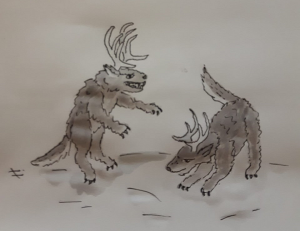Olost
From World of Entorais Wiki
About
Pack hunting carnivores of northern pine forests and tundra.
- Common Names
- Bush hounds
Description
- Classification
- Mammal
- Size
- 80 kg (176 pounds), 1.6 metres (5 feet/ 3 inches) nose to tail
- Appearance
- Olost possess antlers used in territorial displays, marking trees with scrapes, and in fights for dominance amongst the pack hierarchy. The antlers are shed in early winter.
- Sexual dimorphism
- Females tend to be 20% smaller in size and mass. Both males and females grow antlers, although the females tend to develop smaller racks.
- Variance
- A few sub-species exist generally separated by geograhic barriers such as mountain ranges, or large bodies of water.
Ecology
- Habitat
- Tundra, plains, and northern forests.
- Diet
- Olosts eat a variety of terrestrial animals, and shallow water species of fish. They work in coordinated groups to hunt larger prey animals. If hunting is difficult they will resort to scavenging from corpses who died from other means.
Behaviour
- Social grouping
- Olost form packs from a small number of family groups. usually no more than three mated pairs with their offspring, totalling a pack of approximately two dozen members.
- Temperament
- Olost are territorial and will patrol their range to detect and deter other predators from encroaching on their hunting grounds. When on the hunt, the entire pack will stalk prey and use persistence hunting to out last their prey, with individual olosts forcing the prey to keep moving, while the pack conserves energy for the final kill once their chosen prey becomes exhausted from the pursuit.
- Intelligence
- Olost are fairly intelligent, and will communicate across great distances with barks and howls. The are able to coordinate tactics through visual body cues during hunting behaviour to great effect.
- Reproduction
- Mated pairs will couple in the early winter, with the female entering a den for the majority of the season. Between four and six cubs will be live birthed in the spring, and will be sexually mature by their second autumn season.
Sub-Species
Forest Olost
- Stocky and broad shouldered, the forest olosts tend to dark grey and black hides. They form smaller packs on average, and range throughout temperate and subarctic forests.
Plains Olost
- Leaner of form, and possessed of a dusty brown coat. This subspecies is often found in grasslands, light woods, or scrubland.
Tundra Olost
- Near white or silver-grey in colour, with shaggier coats. These olosts hunt on the northern tundra and icepacks. They have the largest ranges of any species and have been known to hunt aquatic mammals such as seals whom come ashore for whelping pups.
Domestication
- General
- Most attempts at domesticating olost have been unsuccessful, due to theri9 wild nature they tend to be uncontrollable, and will return to a feral sate if they can escape captivity.
- Resources
- Fur, Antlers
